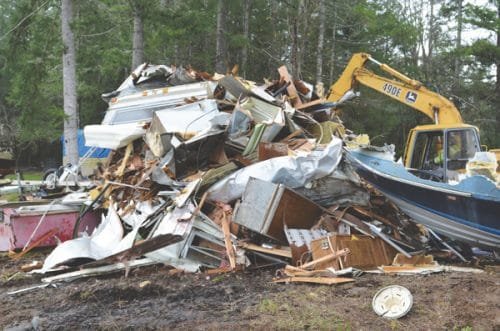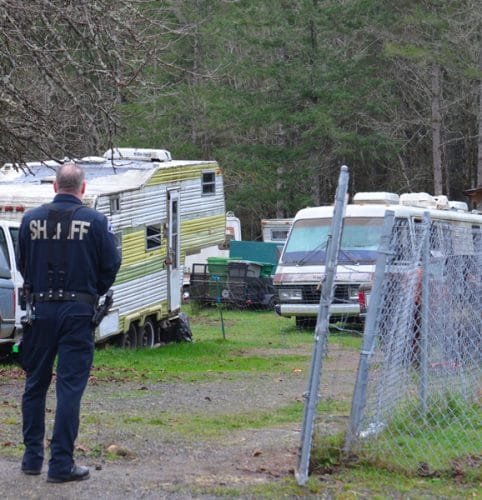 Pierce County removed 143 junk vehicles, 1,440 cubic yards of debris and over 68 tons of other debris from KP properties in 2018. Photo: Lisa Bryan, KP News
Pierce County removed 143 junk vehicles, 1,440 cubic yards of debris and over 68 tons of other debris from KP properties in 2018. Photo: Lisa Bryan, KP News
Pierce County code enforcement officers cleaned up 11 privately owned Key Peninsula properties in 2018 through a legal process known as abatement. Five of those parcels were abated in an agreement with the property owners; six were abated by court order. In total, 159 junk vehicles, 1,560 cubic yards of debris and an additional 168 tons of solid waste, household trash and debris were removed, ultimately at the property owner’s expense.
Of the properties abated under court order, 143 junk vehicles, 1,440 cubic yards of debris and over 68 tons of other debris were removed. Ninety-one percent of those junk vehicles and 82 percent of the debris measured in cubic yards came from just two properties.
Year after year, all seven Pierce County Council members and the elected officials that came before them heard numerous citizen complaints about well-known community eyesores––inappropriate land use, junk vehicles, abandoned houses and public nuisances. Code enforcement officers not only had heavy caseloads with a backlog of unresolved code violations, but lost time responding to frustrated citizens.
The council modified a number of regulatory tools, including increased funding and departmental changes for improved efficiency, but the length of time from complaint to resolution was, in the words of more than a few community residents, “still too damn long.”
The council responded with Ordinance No. 2017-22s, which declared that “public nuisances involving solid waste, junk vehicles, derelict structures––meaning structures that are dangerous, unsafe, insanitary or otherwise unfit for human habitation or occupancy––shall be the highest code enforcement priority of the Pierce County Planning and Public Works Department.”
 Not every KP abatement was voluntary. Photo: Lisa Bryan, KP News
Not every KP abatement was voluntary. Photo: Lisa Bryan, KP News
“The impacts of these public nuisances and code violations pose significant adverse social, economic and environmental impacts on neighboring parcels, neighborhoods and the larger community; threaten the quality of life of Pierce County’s citizens’ ability to be a community in which individuals, families and businesses want to locate; and can reduce property values,” according to the ordinance.
The ordinance authorized the addition of two full-time code enforcement employees and stated the intent of the council to appropriate funds to support abatement of blighted public nuisance properties. It directed the creation of a public portal within the Planning and Public Works Departments’ existing website to allow the public to lodge complaints and increase transparency for tracking the status of code enforcement violations online, freeing up code enforcement staff to do their work.
“We are reactive, not proactive, unless it is a life safety issue,” said Melanie Halsan, assistant director of Planning and Public Works. “Ninety percent of the complaints we are pursuing are based upon someone calling in and saying, ‘I’m not sure what’s going on here but it doesn’t look right,’ or ‘I live next door to this property and they are starting to collect vehicles,’ or ‘There appears to be a contractor’s yard going on.’”
“We’re noticing an increase in the number of complaints in 2019,” Halsan said. “The increased numbers could be a result of ease in reporting from the new portal, people noticing progress made on other parcels, or due to the homeless population throughout the county,” she said.
“In addition to the increase in complaints, our (county) council has also established a 90-day resolution time period for us; by resolution, I mean either we have the property owner clean up the site or working with us on a compliance plan––otherwise we forward the case to our prosecuting attorney to obtain a warrant of abatement, which is a court order.
“Our goal is to work with people to bring the property into compliance. If the property owner can’t afford to bring the site into compliance, we can help them,” Halsan said. “We can work through a Cooperative Abatement Right of Entry agreement with the owner. We go onto the property, we clean it up for them, and a lien is placed on it but allows us to go through without having to get a court-ordered warrant of abatement.”
“There was an administrative appeal process that was removed from the code. We didn’t see that it was helping our process, but rather delaying resolution of these sites,” Halsan said. Those changes were based on requests from the prosecuting attorney’s office or from code enforcement officers.
“We do have people that fight us; they believe they have a right to either have the trash on their property or the junk vehicles or they disagree with how we’ve classified those vehicles,” Halsan said. “We go by our regulatory standards and if someone thinks we’ve erred, there is a process they can go through.”
“The majority of cases are resolved within 120 days,” Halsan said. “We’re getting closer. Our goal is to be able to track what we’re doing and start narrowing down the time period to hit the mark on 90-day resolution.”
UNDERWRITTEN BY THE FUND FOR NONPROFIT NEWS (NEWSMATCH) AT THE MIAMI FOUNDATION, THE ANGEL GUILD, ADVERTISERS, DONORS AND PEOPLE WHO SUPPORT INDEPENDENT, NONPROFIT LOCAL NEWS